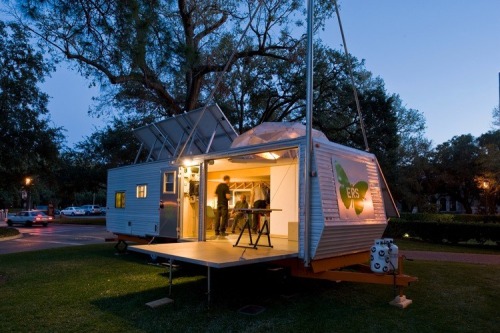
In August 2006, on a visit to post-Katrina New Orleans, Paul Villinski wished he could transport his studio from New York to the Lower Ninth Ward, so he could create work in response to the conditions he found there. Creating Emergency Response Studiowas his solution. Over seven months, Villinski transformed a salvaged FEMA-style trailer into a rolling, off-the-grid live/work space that could house displaced artists, or allow visiting artists to “embed” in post-disaster settings.
“I believe we ought to consider deploying artists as part of the mix of disaster workers, medical personnel, NGO’s, architects, and urban planners - those people charged with responding to, repairing, and re-envisioning disaster sites like New Orleans,” says Villinski. To this end, from April to October of 2008, Villinski worked nonstop, gutting, rebuilding, and playfully rethinking a 30-foot Gulfstream “Cavalier” trailer virtually identical to the 50,000 trailers built by Gulfstream for FEMA. Re-born as theEmergency Response Studio, the trailer’s formaldehyde-riddenoriginal materials are replaced by entirely “green” technology and building materials, including recycled denim insulation, bamboo cabinetry, compact fluorescent lighting, reclaimed wood, and natural linoleum floor tiles made from linseed oil. It is powered by eight mammoth batteries that store energy generated by an array of solar panels and a “micro” wind turbine atop a 40-foot high mast. Not only practical, Emergency Response Studio is a visually engaging structure with an expansive work area featuring a wall section that lowers to become a deck. A ten-foot, elliptical geodesic skylight allows extra headroom and natural lighting in the work area. Though designed as an artist’s studio and residence, Emergency Response Studio is an ingenious prototype for self-sufficient, solar-powered mobile housing.
Emergency Response Studio is installed near the entrance of Rice campus at the southeast corner of Lovett Hall next to Rice Gallery. It is the second in an ongoing series of architectural installations; the first was Bamboo Roof by Japanese architect Shigeru Ban. Paul Villinski’s project is accompanied byEmergency Response Studio: Process, an installation in Rice Gallery which details the construction process, and features further information about “movable” housing.
ABOUT THE ARTIST
Paul Villinski was born in York, Maine in 1960. He received a BFA with honors from The Cooper Union for the Advancement of Science and Art, New York in 1984. Villinski’s work has been exhibited extensively, most recently in two major exhibitions,Prospect.1 New Orleans (2008), and Second Lives: Remixing the Ordinary, the inaugural exhibition of the Museum of Arts and Design, New York, on view through February 15, 2009. His work will be included in Cutters, opening at the Hunterdon Art Museum, Clinton, New Jersey, in February 2009. Paul Villinski lives and works in New York City.
Written by Doug Britt